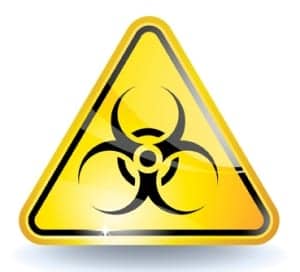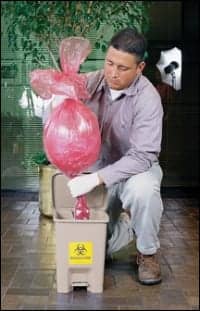
In the professional cleaning industry, it seems that just about everyone and every location have transferred, have begun to transfer, or are now considering transferring to green cleaning. However, there appears to be one very large industry segment that has trailed behind other industries in jumping on the green-cleaning bandwagon: health care.
The health care industry encompasses many segments, from hospital and clinics to long-term living centers and rehabilitation centers. These facilities are designed to take care of people who are ill or injured or who can no longer care for themselves. However, in virtually all of these areas, the adoption of environmentally preferable cleaning products has been a relatively slow process when compared to other types of facilities that have more eagerly embraced green cleaning, such as schools and offices.
There are several reasons for this, according to Stephen Ashkin, president of the Ashkin Group, and former director of product development for Seventh Generation, a maker of naturally safe and effective household products–who is known as the “father of Green Cleaning” within the professional cleaning industry. “Some of these [reasons] are quite understandable, while others are due to very strict rules and regulations that impact most all health care facilities,” he says.
For instance, Ashkin says that many hospitals are very concerned about nosocomial (hospital-acquired) infections, which have been on the rise in certain medical settings. Hospital administrators typically do not want to risk “making any changes at all, green or not green, that might jeopardize patient health, especially when there is a potential health risk involved,” he says.
Another reason is legal. State and federal government regulations have mandated that specific types of cleaning products, mostly disinfectants, be used in specific areas of a medical facility. For instance, emergency care and surgical areas typically are required by law to use very powerful disinfectants. And in the United States, he says the word “green” cannot even be applied to these products.
And there is one more reason many health care locations have moved cautiously when it comes to green cleaning. “Surprisingly, some health care facility administrators still believe green products are more costly than conventional cleaning products and do not perform well,” says Ashkin. “This may have been true of [green] products made 15 to 20 years ago but certainly not today.”
TERMS AND DEFINITIONS

Stephen Ashkin
Before we go further in discussing green cleaning, we better make sure we clearly understand what it is. Green cleaning can be defined very simply as “cleaning to protect health without harming the environment.” More broadly, it means using cleaning tools, chemicals, equipment, and other products that have a reduced negative impact on the environment, the user of the products, and building occupants.
We should also be aware that green cleaning is evolving. It now involves more than just using products that are more protective of the environment. It also means using products that help promote sustainablity. This can be from the way the product is made, using natural and renewable resources, to the way it is packaged, using recycled materials and, if a chemical, filling into larger containers to reduce packaging needs and the fuel used to transport these products.
The big concern about many conventional chemical products currently in use in health care facilities, whether hospitals or rehab locations, is that many are made from ingredients known to be harmful to human health. Several cleaning agents commonly used in medical facilities, everything from conventional window cleaners to all-purpose cleaners, have been known to cause a variety of health reactions such as respiratory problems; eye, nose, and throat irritation; and skin rashes.
“The severity of these reactions can vary and can negatively impact some people more than others,” says Ashkin. “However, one thing we do know is the severity of the problem tends to increase over time and [with the] extent of exposure.”
Ashkin points out that it is some of the antimicrobial products and disinfectants used extensively in health care cleaning that can be among the most environmentally harmful of all. “These products have served us well and have helped stop the spread of disease and contamination,” says Ashkin, “but we must also be aware of the problems they can cause for the environment.”
In fact, the Environmental Protection Agency (EPA), which regulates antimicrobial cleaners and disinfectants in the United States, classifies these products as pesticides, with some having a more adverse impact on the user and the environment than others. Some of these products include:
- “Quats” or quaternary ammonium compounds, such as benzalkonium chloride, are effective as sanitizers or disinfectants on a wide range of bacteria and some viruses. These products can be corrosive to some metals and surfaces, and there are concerns that quats in high concentrations can cause or trigger asthma.
- Phenols are able to kill more organisms than quats, but they have very high environmental and health consequences. They can also destroy plastic, paint, and rubber surfaces.
- Aldehydes are often used as a form of disinfectant. These are extremely harmful to human health and the environment and can cause headaches, nausea, vomiting, and skin, eye, and respiratory problems.
- Chlorine bleach has served us well in many ways and is a very powerful disinfectant used in many medical/rehab facilities. But it is also known to be corrosive to eyes and skin and a respiratory irritant and, when mixed with other commonly used cleaning products, can produce a poisonous gas.
- Alcohol can also be used as a disinfectant, and it can be a respiratory irritant.
IMPLEMENTING A GREEN CLEANING PROGRAM

Biohazard waste should always be in red bags and treated separately than other waste items.
As mentioned earlier, the use of some of these products and ingredients is mandated by law for use in specific areas of a health care facility. “We must be sure to use them only in those areas where legally required,” says Ashkin. “Restricting them to just those areas is being environmentally responsible and the first step in green cleaning in a medical facility.”
If this is the first step in greening a health care or rehab facility, what other steps can be taken? Ashkin suggests that health care and rehab facilities divide their locations into three key zones. Based on how the zone is used, it can be determined if green cleaning products, specifically green chemicals, may or may not be used. These three zones are:
- Critical care zones: These are the areas where specific disinfectants are mandated by law.
- Semicritical care zones: These include areas such as restrooms, physical therapy rooms, and nonemergency clinics where there may still be a high level of disinfection needed but where facility managers have greater flexibility when selecting products and can select green cleaning products.
- Noncritical care zones: These include administrative areas, shopping areas, and so on. Green cleaning products should be used in these areas.
It should not be overlooked that green cleaning involves more than just the use of green cleaning chemicals. According to Michael Schaffer, president of Tornado Industries, green cleaning also involves the use of cleaning equipment that is kinder to the environment, such as HEPA-filtered vacuum cleaners. “These vacuum cleaners are specifically designed to capture and trap contaminants in the exhaust of the machine,” Schaffer says. “This prevents them from becoming airborne and marring air quality.”
Schaffer also says rehab facility managers should select a new generation of floor-care machines that are designed to use less water and chemical, making them both more sustainable and greener. Additionally, cylindrical brush technology, a new type of floor-care equipment that uses brushes instead of pads to clean, polish, and scrub floors, can use as much as 30% less water and chemical.
Earlier we mentioned that in the United States disinfectants cannot be marketed, labeled, or advertised as “green.” This is because these products are designed to kill microbes and thus have been designated as pesticides by the EPA. However, this policy is being revisited, and working with Ashkin and other cleaning industry leaders, it is likely the EPA will change this policy in the future.
When it does, it should help speed the transference from conventional to green cleaning in rehabilitation and other types of medical facilities. Although it has been a slow process, many medical facilities of all types are looking for ways to green their locations. The ultimate goal of these facilities is to help protect and foster health. Green cleaning is one of the best ways to accomplish this.
Robert Kravitz is a former building service contractor, author of two books on the professional cleaning industry, and a writer for the professional cleaning and building industries.





